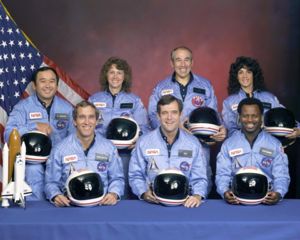Difference between revisions of "Space Shuttle Challenger"
(→Cause: smart Jewish guy figures it out) |
DavidB4-bot (Talk | contribs) (Spelling, grammar, and general fixes) |
||
| (2 intermediate revisions by 2 users not shown) | |||
| Line 1: | Line 1: | ||
[[Image:Space Shuttle Challenger Crew.jpg|thumb|right|300px|The Space Shuttle Challenger crewmembers are: in the back row from left to right: Mission Specialist, Ellison S. Onizuka, Teacher in Space Participant Sharon Christa McAuliffe, Payload Specialist, Greg Jarvis and Mission Specialist, Judy Resnik. In the front row from left to right: Pilot Mike Smith, Commander, Dick Scobee and Mission Specialist, Ron McNair.]] | [[Image:Space Shuttle Challenger Crew.jpg|thumb|right|300px|The Space Shuttle Challenger crewmembers are: in the back row from left to right: Mission Specialist, Ellison S. Onizuka, Teacher in Space Participant Sharon Christa McAuliffe, Payload Specialist, Greg Jarvis and Mission Specialist, Judy Resnik. In the front row from left to right: Pilot Mike Smith, Commander, Dick Scobee and Mission Specialist, Ron McNair.]] | ||
| − | The '''Space Shuttle Challenger''' disintegrated due to O-ring failure 73 seconds after lift-off on January 28, 1986, killing all seven members on board. Those killed included the first private citizen to fly on a [[space shuttle]], who was a high school teacher. <ref>http://www.fas.org/spp/51L.html</ref> | + | The '''Space Shuttle Challenger''' disintegrated due to O-ring failure 73 seconds after lift-off on January 28, 1986, killing all seven members on board. Those killed included the first private citizen to fly on a [[space shuttle]], who was a high school teacher.<ref>http://www.fas.org/spp/51L.html</ref> |
President [[Ronald Reagan]] mourned the tragedy in an address to the [[United States of America|nation]]: | President [[Ronald Reagan]] mourned the tragedy in an address to the [[United States of America|nation]]: | ||
| Line 21: | Line 21: | ||
NASA had said the O-rings had a safety factor of 3, which [[Richard Feynman]] later exposed as untrue. | NASA had said the O-rings had a safety factor of 3, which [[Richard Feynman]] later exposed as untrue. | ||
| − | * [[SRB]] engineers had previously warned about problems in the o-rings, but had been dismissed by NASA management.<ref> [http://duartes.org/gustavo/blog/post/richard-feynman-challenger-disaster-software-engineering Richard Feynman, the Challenger Disaster, and Software Engineering]</ref> | + | * [[SRB]] engineers had previously warned about problems in the o-rings, but had been dismissed by NASA management.<ref>[http://duartes.org/gustavo/blog/post/richard-feynman-challenger-disaster-software-engineering Richard Feynman, the Challenger Disaster, and Software Engineering]</ref> |
| − | * For example. in determining if flight 51-L was safe to fly in the face of ring erosion in flight 51-C, it was noted that the erosion depth was only one-third of the radius. It had been noted in an experiment cutting the ring that cutting it as deep as one radius was necessary before the ring failed. Instead of being very concerned that variations of poorly understood conditions might reasonably create a deeper erosion this time, it was asserted, there was "a safety factor of three." This is a strange use of the engineer's term, "[[safety factor]]."<ref> [http://www.ralentz.com/old/space/feynman-report.html Feynman's Appendix to the Rogers Commission Report on the Space Shuttle Challenger Accident]</ref> | + | * For example. in determining if flight 51-L was safe to fly in the face of ring erosion in flight 51-C, it was noted that the erosion depth was only one-third of the radius. It had been noted in an experiment cutting the ring that cutting it as deep as one radius was necessary before the ring failed. Instead of being very concerned that variations of poorly understood conditions might reasonably create a deeper erosion this time, it was asserted, there was "a safety factor of three." This is a strange use of the engineer's term, "[[safety factor]]."<ref>[http://www.ralentz.com/old/space/feynman-report.html Feynman's Appendix to the Rogers Commission Report on the Space Shuttle Challenger Accident]</ref> |
==References== | ==References== | ||
Revision as of 15:24, June 24, 2016

The Space Shuttle Challenger disintegrated due to O-ring failure 73 seconds after lift-off on January 28, 1986, killing all seven members on board. Those killed included the first private citizen to fly on a space shuttle, who was a high school teacher.[1]
President Ronald Reagan mourned the tragedy in an address to the nation:
Today is a day for mourning ... a national loss .... There's a coincidence today. On this day 390 years ago, the great explorer Sir Francis Drake died aboard ship off the coast of Panama. ...
Well, today we can say of the Challenger crew: Their dedication was, like Drake's, complete. The crew of the space shuttle Challenger honored us by the manner in which they lived their lives.
We will never forget them, nor the last time we saw them, this morning, as they prepared for their journey and waved good-bye and 'slipped the surly bonds of earth' to 'touch the face of God.'
Cause
Despite an "investigative" process (apparently designed to prevent discovery of the cause), physicist Richard Feynmann eventually learned that O-rings which provided crucial seals failed in the unusually cold weather of the launch. It was freezing cold that day (29 degrees F), whereas it had been at least 53 degrees on all previous launches.
NASA coverup
NASA had said the O-rings had a safety factor of 3, which Richard Feynman later exposed as untrue.
- SRB engineers had previously warned about problems in the o-rings, but had been dismissed by NASA management.[2]
- For example. in determining if flight 51-L was safe to fly in the face of ring erosion in flight 51-C, it was noted that the erosion depth was only one-third of the radius. It had been noted in an experiment cutting the ring that cutting it as deep as one radius was necessary before the ring failed. Instead of being very concerned that variations of poorly understood conditions might reasonably create a deeper erosion this time, it was asserted, there was "a safety factor of three." This is a strange use of the engineer's term, "safety factor."[3]